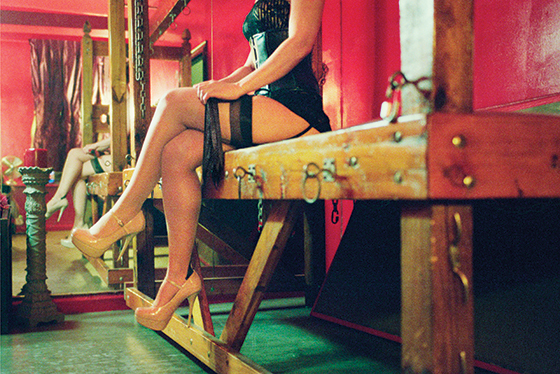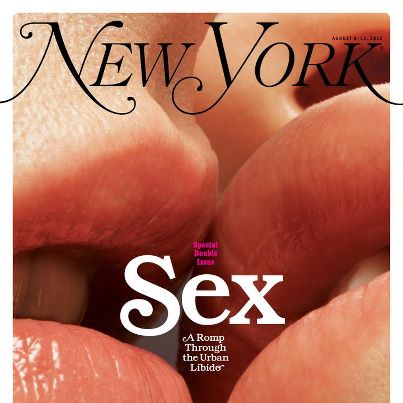This week New York Magazine printed an issue dedicated entirely to boning. Did you know? And guess what? It’s not entirely about heterosexuals in missionary position — there are so many more perspectives than that. And my guess is that the New York Magazine Sex Issue will give you feelings, because it gave me feelings.

via New York Magazine
It was odd, reading these articles. There is so much right with them — the article “He & He & He“, for example, spotlights the work and home life of Benny, Jason and Adrian, a “throuple,” or three men in a polyamorous relationship. They collectively own and run Cockyboys, a gay porn company, and otherwise do very “normal” things, like crochet and raise dogs and collect art. The article does such a fantastic job of presenting three well-rounded human beings that work in the sex industry and really normalizes polyamory: Paper’s Drew Elliot is quoted as saying “It’s amazing. It’s modern. There’s nothing sensational about them — the relationship isn’t theater. It just works.”
They also acknowledge that bisexuals exist. That’s something they totally did right. This is not a publication that participates in bisexual erasure:
I told my dad first. When I said I was dating a woman, he said, “Oh, so you’re a lesbian.” I said no. Then he kind of wiggled his hand and said, “So you’re kind of like this, huh?” He understood.
Or the adorable photos of young couples kissing by Richard Kern. They’re just cute, and one of the couples is gay (and also effing adorbs.)

via New York Magazine
So why was it odd, if there was just so much right? Reading along, having lots of sex-positive feelings, and then WHAM. Problematic statement. There’s the jarring gender essentialism:
Sometimes, if I’m with a man, I’ll miss the emotional connection and nurturing that I’ve found women are more likely to offer. Or if I’m with a woman, I can miss the way a man can take charge. –from Bisexual Testimonials
The slightly strange use of a trans* identity in comparing masculine and feminine aspects of a cisgender man:
Dressed in a formal shirt and suspenders, he is as two-dimensionally thin and neatly pressed as an envelope. “I wouldn’t be shocked if I learned that he was the world’s most convincing female-to-male transsexual,” Boardman says. –from He & He & He
The idea that the world and societal norms are default heterosexual and that any deviation is purely imitation:
Surrounded by couples (lesbians and gays getting married and having children, imitating, ironically, all these years later, their straight brethren), she is mostly comfortable still reveling in the chase. –from Sex: The Multiplicity of Desire
Or the entire “Married Sex” article, in which the couple is at best constantly thwarted when they try to have sex, or at worst just not that into each other. That one’s less problematic and more a bit of a bummer.
Despite the gender essentialism, the occasional sex worker negativity and misogyny, and even this bizarre conflation of butch, stone and trans* identities that Sex: The Multiplicity of Desire takes part in, it’s a wonderful read filled with quite a few different examples of people, lives and perspectives. Fascinating. And it’s worth noting that a lot of the problematic statements come from those who are interviewed, and not necessarily from the journalists themselves.

via New York Magazine
Sex is a difficult thing to write about because there are about as many facets to sex and sexuality as there are people on the planet. More even, because human beings can be capable of changing their sexuality and sexual proclivities as often as they change their underwear. No one article can encompass sex and all the perspectives on it. Not even a collection of articles as well-chosen and well-written as this one can do it. Most people make problematic statements about sex because their views are based entirely on personal experience — at what other point do you really get to experience someone else’s sex? That’s why mainstream publications need to be doing what New York Magazine is doing: collecting experiences so that there isn’t one authority out there and making them publicly available to incite discussion. Sex makes up a good deal of our lives — let’s start talking about it. Writing about it. Having real discussions about sex. In U.S. culture, sex is often looked at as worse than violence on the shame-scale. Talking about sex, all different kinds of sex, removes the shame and allows us to move past these often problematic attitudes surrounding pleasure. The very presence of this publication lets us find our own reflections in the experiences of others and provokes conversation about a commonly taboo topic. I commend New York Magazine for even touching a topic that can be so incendiary, problems included.

i’m really excited to read these articles now; thank you for writing this, ali!
when i first read the ny mag sex articles i had a LOT of feelings, thoughts, opinions, and thought, ‘my gosh, this would be super hard to write about/sum up in an article,’ but you did it! I guess it’s because, as you say, you’re a sex blogger, you got it.
:0) Thank you, Malaika.
That magazine cover is one of the hottest pics ever to be on this website!
Kudos to New York Magazine for taking this on. Sexuality is not an easy thing to sum up.
i like this
so, my eyes decided to only look at the top left part of the cover for a second, and I thought that lip was some weird, flesh colored mushroom O.o
I did that too, except I saw heels of feet. Once I realized what it actually is, it suddenly became a lot
more attractive.
Me too, I saw mushrooms first and then some male body part and finally just a sweet kiss. Jeez, dirty mind.
Maybe this is a stupid question, but why the asterisk by the word “trans”? Is there something I missed….?
The * implies an umbrella-term, meaning many different identities fall under the category of “trans-“. These can include, but are not limited to, transgender, transsexual, Two-Spirit, gender-fluid, and genderqueer. However, not everyone with these identities would personally label themselves as a trans* individual.
(I think. Did I miss anything? Someone please elaborate; I didn’t want to assume anything from my cis-perspective that isn’t accurate or appropriate.)
Nope, it’s all good, that’s right.
Thanks! That makes sense….
On Friday night I got very drunk with a lot of my friends, and I was really surprised at how easily me and the two girls discussed sex, and how awkward a lot of the boys were about it. Props for the New York Magazine for being open. Now just to get everyone else to that level…
I wish they had interviewed a bi woman in a same-sex relationship myself…as someone in the comments said, they are grossly underrepresented and basically invisible in the community.
Yeah! That was me. Somebody had to say it…
Point of clarification. Responding to the assertion that same-sex couples marrying are imitating opposite-sex couples who brought us marriage, you wrote “The idea that the world and societal norms are default heterosexual and that any deviation is purely imitation”.
Opposite sex couples invented and have subsequently engaged in a constructed social practice. Same-sex couples decide to engage in the exact same practice, with the same specific rituals, (justifiably) demanding the same benefits from that practice. That is imitation.
Is the assertion that same-sex couples who marry are imitating opposite-sex couples who marry claiming that the world is by default heterosexual and that any deviation is imitation? No. That assertion just shows that one societal norm (marriage) is default heterosexual (that’s the history), and that pursuing that specific norm is imitation.
Marrying IS conforming to the norm. A deviation from the norm is to Not marry. Not marrying is refusing to imitate. Not marrying is queer.
This article was fantastic. When I read this issue of NY mag, I was really excited at all of the good/positive aspects of the articles and did note that most of the bad/negative/problematic words or terms were used by the people being interviewed rather than the author or interviewer. I did wish that they had shown maybe another queer relationship in the pictures of couples and at least one queer couple of color/a queer couple who included a POC. All in all though, NY mag didn’t do a bad job. Good for them!